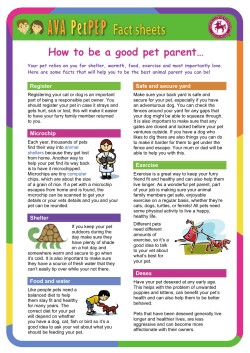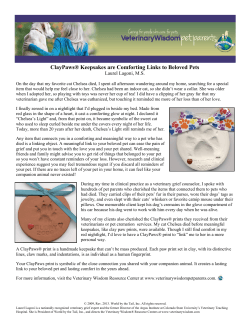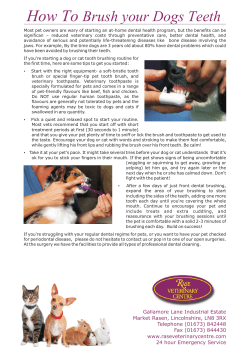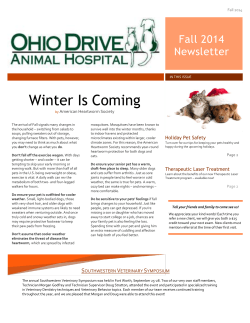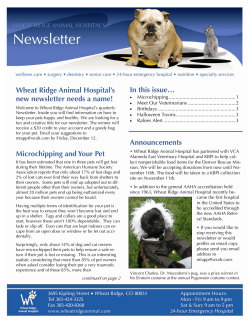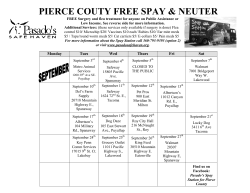
Consultation on ‘Pet Travel: changes to the EU scheme’
Consultation on ‘Pet Travel: changes to the EU scheme’ Summary of responses to the public consultation November 2014 www.gov.uk/defra www.wales.gov.uk www.scotland.gov.uk © Crown copyright 2014 You may re-use this information (excluding logos) free of charge in any format or medium, under the terms of the Open Government Licence v.3. To view this licence visit www.nationalarchives.gov.uk/doc/open-government-licence/version/3/ or email PSI@nationalarchives.gsi.gov.uk This publication is available at www.gov.uk/government/publications Any enquiries regarding this publication should be sent to us at: EUPetTravel.Consultation@defra.gsi.gov.uk Change note: 14/11/2014 Section 10.2 amended to include further detail in relation to quarantine to make it clear that the four month maximum period relates to rabies requirements. Contents Background.......................................................................................................................... 1 Overview of responses ........................................................................................................ 1 Summary of responses to consultation questions................................................................ 2 Response............................................................................................................................. 9 Next steps .......................................................................................................................... 14 Annex A: List of organisations responding to the consultation ........................................... 15 Background 1. Purpose of the consultation 1.1. Defra, the Welsh Government and the Scottish Government consulted on changes to the EU pet travel scheme from 4 August until 14 September 2014. 1.2. These changes are introduced by a new EU Regulation (576/2013), which was published in June 2013 and is due to come into effect on 29 December 2014. This Regulation repeals and replaces the current EU Regulation (998/2003). The EU pet travel scheme places requirements on travelling pets to keep the UK free of diseases, specifically rabies and the Echinococcus multilocularis (EM) tapeworm. Controls relating to the EM tapeworm are established under Commission Delegated Regulation (EU) (No 1152/2011) and will remain unchanged. 1.3. Whilst the fundamentals of the pet travel scheme will remain the same a number of changes have been introduced to strengthen the regime, including a more secure pet passport. Further information on these changes can be found on the Defra website: https://www.gov.uk/government/publications/pet-travel-guidance-onchanges-to-the-eu-scheme-from-29-december-2014 1.4. The consultation invited views from pet owners and other stakeholders in respect of three key areas: 1.5. • Information on how many pets people generally travel with and who assists in the preparation of pets for travel; • Comments on our proposed approach to implementing those areas of the EU Regulation where member states have flexibility in how they are implemented; and • Views on the impact of the changes introduced by the new Regulation. Prior to the consultation, informal consultation activities were undertaken with a number of stakeholder groups. This included a webinar presentation, hosted by the British Veterinary Association, for which 1003 people registered. The consultation was promoted through social media, widely advertised on government websites and received the largest number of page views for any Defra consultation in August. Overview of responses 2. A total of 170 responses were received, either directly through the consultation portal or via email. A list of those organisations that responded to this consultation is included as Annex A. 1 Summary of responses to consultation questions 3. Breakdown of respondent information 3.1. 3.2. 3.3. 3.4. 3.5. In Question 5 respondents were asked whether they owned pets. A total of 158 people responded to this question as follows: • Yes: 140 (88.6%) • No: 18 (11.4%) Respondents were then asked whether they had ever taken their pet abroad. A total of 141 people responded to this question as follows: • Yes: 46 (32.6%) • No: 95 (67.4%) Pet owners were also asked to indicate the number of pets they usually travelled with. A total of 56 people responded to this question as follows: • 1 pet: 25 (44.6%) • 2 pets: 16 (28.6%) • 3 pets: 6 (10.7%) • 4 pets: 5 (8.9%) • 5 pets: 1 (1.8%) • More than 5 pets: 3 (5.4%) In Question 6 respondents were asked whether they had ever travelled abroad with their pets to attend a show, competition or sporting event. A total of 153 people responded to this question as follows: • Yes: 18 (11.8%) • No: 135 (88.2%) Those who had travelled abroad for this purpose were asked how many pets they normally travel with. A total of 18 people responded to this question as follows: • 1 pet: 4 (22.2%) • 2 pets: 5 (27.8%) 2 3.6. 3.7. • 3 pets: 4 (22.2%) • 4 pets: 1 (5.6%) • 5 pets: 1 (5.6%) • More than 5 pets: 3 (16.7%) In Question 7 those responding to the consultation were asked to indicate whether they were a veterinarian. A total of 159 people responded to this question as follows: • Yes: 94 (59.1%) • No: 65 (40.9%) Respondents were asked in Question 8 whether they currently implanted microchips. A total of 161 people responded to this question as follows: • Yes: 112 (69.6%) • No: 49 (30.4%) 4. Summary of responses relating to changes to the EU pet travel regime 4.1. The second section of the consultation asked for views on the forthcoming changes to the pet travel regime. The questions and a summary of responses are outlined below. 4.2. Question 9: Under Article 5 of the new Regulation, individuals travelling with their pets to attend a show, competition or sporting event (or training for such an event) will be exempt from the more stringent rules that will be introduced for the movement of more than five pets. In order to prevent abuse of this exemption, the Regulation requires individuals to provide proof that they are travelling to attend an eligible event. We are therefore interested in knowing whether the following information is usually included on the registration materials that are issued to participants by those organisations that arrange competitions, shows and sporting events. A total of 50 people responded to this question as follows: • Name of event: 42 • Address of event: 36 • Date(s) the event is taking place: 42 3 • Sponsoring organisations: 20 • Other (please provide details): 20 Responses received through the ‘other’ box highlighted that information relating to the pet’s registration number, name and competition class may also be in these materials. In addition, it was noted that contact details for the organising committee were often included whilst the pet may also be issued with an entry and exit pass to the event. 4.3. Question 10: The new Regulation gives member states the option of allowing individuals other than veterinarians to implant microchips for the purposes of pet travel, but requires them to establish the minimum training that person must have received (Article 18). Our preferred approach is to allow nonveterinarians to implant microchips providing they are either a registered veterinary nurse, have previously been trained on a course containing a practical element or attend an approved training course. In England and Wales the intention is to align with forthcoming legislation requiring the compulsory microchipping of dogs and laying down the training required for implantations. The Scottish Government are currently considering responses to their microchipping consultation but anticipate that any legislative requirements for microchipping in Scotland could also be aligned. Do you have any comments on this approach? 4.4. A total of 63 respondents agreed that only those who have received suitable training should be permitted to microchip pet animals being prepared for travel. A further 22 respondents felt that the provisions should be more stringent and that only veterinarians, veterinary nurses or registered students should be authorised to implant microchips. No responses were received suggesting that untrained individuals should be permitted to implant microchips. 4.5. A number of respondents also used this opportunity to highlight the importance of communicating this change to those individuals who currently implant microchips. Further questions were raised regarding enforcement of this provision and how veterinary staff should deal with pet animals presented to them for pet travel that have already been microchipped. A number of respondents requested further information on the training courses that would be available. 4.6. In order to consider the impact of this new requirement those responding on behalf of veterinary practices were asked who currently microchips those pets being prepared for travel and if they intended to register any staff on the new training course. 4.7. A total of 82 respondents indicated that pets being prepared for pet travel were microchipped either by veterinarians or veterinary nurses (including trainees). Only 1 respondent to this question indicated that they may register staff at their veterinary practice for the new training course and only if this was necessary to ensure full 4 compliance with the new requirement. Further information relating to training courses and guidance on how this change may impact on completion of the pet passport were requested by a number of respondents. 4.8. Question 11: The EU Regulation introduces a requirement for veterinarians to keep certain records, for a period of at least three years (under Article 22). Our preferred approach to implementing this requirement is to include information in the guidance and training provided to vets authorised to issue passports. Any vet found to be in contravention of this record keeping requirement may have their authorisation removed. Do you have any comments on this? 4.9. A total of 78 respondents agreed that veterinarians should be required to retain records in relation to the information entered onto the pet passport, as outlined in the consultation document. A further 5 respondents agreed that records should be retained but felt that, as a precaution, they should be kept for longer than 3 years. Whilst no respondent to this question disagreed with the principle of record keeping, 1 respondent felt that removing authorisation from veterinarians in the event of noncompliance with this requirement would be disproportionate. A number of respondents queried the format these records should take and what needed to happen in the event of practice closure or in situations where a veterinarian moved to a new practice. 4.10. Question 12: Our assessment is that because the fundamentals of the scheme will remain the same we do not anticipate that there will be significant adoption costs for business to implement the relevant changes. Do you have any comments? 4.11. A total of 31 respondents agreed that there would be no significant costs to business in relation to these changes whilst 20 respondents highlighted possible impacts. These impacts primarily related to potential increases in the cost of preparing a pet for travel abroad owing to an increase in the number of pages/fields to be completed by the issuing veterinarian. It was highlighted by 4 respondents that if they were required to send staff on microchipping training courses or ascertain whether someone who had previously implanted a chip was appropriately trained this would also incur costs. Another respondent noted that a cost-recovery project currently underway within the Animal and Plant Health Agency (APHA) 1 may lead to veterinary practices being charged for pet passports (these are currently provided free of charge by APHA). This is being considered separately as part of a wider service delivery project and any proposals will be opened to consultation. 1 The successor body to the Animal Health and Veterinary Laboratories Agency (AHLVA) 5 5. Summary of responses relating to derogations 5.1. The third section of the consultation asked a series of questions relating to provisions introduced by the new Regulation that member states may choose to make use of. The questions and a summary of responses are outlined below. 5.2. Question 13: Under the current pet travel scheme member states can authorise the movement of young, unvaccinated, animals provided they meet a number of conditions. This option will also exist under the new Regulation (Articles 7 and 11). The UK has never authorised these movements and we do not intend to do so now. Do you have any comments? 5.3. A total of 141 responses were received in relation to this question. Responses strongly supported the UK’s current position in relation to this derogation, with respondents citing concerns surrounding the welfare of animals being transported, the disease risks associated with the movement of unvaccinated pets and the potential for such a provision to be abused. Only 3 respondents indicated that they would be in favour of the UK authorising the movement of young, unvaccinated pets. 5.4. Question 14: The UK currently allows pets to enter the country and move directly into quarantine in situations where their owners are not able to make them compliant with the pet travel scheme prior to departure (for example, in cases where they need to move at short notice). Article 32 of the new Regulation explicitly allows member states to authorise the movement of these pets in situations where ‘exceptional circumstances’ require an owner to enter the country at short notice. Do you have any comments about us continuing to allow these pets to enter via quarantine? A total of 81 respondents agreed that in certain situations it should be possible for a pet animal to enter the country and move directly into quarantine, with only 4 respondents disagreeing with this proposal. A number of respondents highlighted that this practice should only be permitted in ‘exceptional circumstances’, with 2 respondents specifically requesting that use of this derogation should be kept under review. Four respondents additionally raised concerns regarding the number of quarantine kennel spaces currently available and sought confirmation that use of this derogation would not impact upon wider enforcement of the EU pet travel scheme. 5.5. Question 15: The new EU Regulation introduces a maximum quarantine period for those pets that are found to be non-compliant and permits member states to determine the length of this period, up to a maximum of 6 months. Do you have any comments on our proposal to set this period at 4 months? A total of 119 responses were received to this question. The approach proposed in the consultation document was to introduce a maximum quarantine period, which 6 would be set at 4 months. Under this proposal, where non-compliant pet animals are placed into quarantine they will be detained until they are compliant with the EU pet travel rules and for no longer than 4 months. This 4 month maximum was expressly supported by 52 respondents. However, responses received from 22 consultees indicated a preference for this maximum quarantine period to be set at 6 months. It is worth noting that a number of respondents to this question believed that the UK currently operates a 6 month maximum quarantine period for non-compliant pets, which is not the case. Under the current rules non-compliant pet animals must be quarantined until they are compliant with the pet travel rules. For those travelling from EU or listed third countries this period of time does not normally exceed 3 weeks whilst those travelling from unlisted countries can usually be brought into compliance in 4 months. No maximum period for quarantine currently exists, which means that in situations where a pet cannot be brought into compliance (e.g. owing to an allergy or where the vaccine does not produce a response) there is no mechanism to release them from quarantine. It is for this reason that a maximum quarantine period has been introduced by the EU Regulation. The overwhelming message from those who commented on this proposal was that any decision establishing a maximum quarantine period must be based on scientific evidence regarding the incubation period of rabies. This view was expressed both by respondents who did not state a preferred time period and by many who indicated that they supported either a 4 month or 6 month maximum. It was noted by many respondents that a 4 month period would capture the vast majority of cases where a pet was incubating rabies at the point it entered quarantine and was therefore an appropriate quarantine period. A more precautionary approach was encouraged by other respondents, who felt that in light of the possibility that the incubation period may extend beyond 4 months, a 6 month quarantine period should be introduced. Welfare considerations were also raised, with 2 respondents noting that a 4 month quarantine period could bring welfare benefits without significantly increasing the rabies risk. Whilst echoing this view 1 respondent noted that in light of the fact that the incubation period could extend beyond both 4 and 6 months the decision regarding a maximum needed to be carefully considered. 6. Summary of final comments and suggestions 6.1. The final section of the consultation asked respondents to consider the impact of the changes and invited them to submit any further comments. The two questions are outlined below, together with a summary of responses. 6.2. Question 16: To what extent do you agree that there are benefits to the changes introduced by the new EU pet travel Regulation? A total of 161 responses were received for this question: 7 • Strongly agree: 18 (11.2%) • Agree: 55 (34.2%) • Neither agree nor disagree: 55 (34.2%) • Disagree: 25 (15.5%) • Strongly disagree: 8 (5%) These figures indicate that 45% of respondents to this question either agreed or strongly agreed that the changes to the pet travel regime will bring benefits. It is also worth noting that a number of those respondents who indicated that they neither agreed nor disagreed, disagreed or strongly disagreed had responded favourably to a number of questions relating to the proposed changes but expressed concerns relating to the wider pet travel scheme. 6.3. Question 17: Do you have any further comments or suggestions? A total of 118 responses were received for this question covering a range of topics. A number of respondents used this opportunity to indicate that they were pleased with the proposed changes, particularly in relation to the improved security of the pet passport and moves to strengthen the regime against abuse. It was suggested, however, that the pet passport could be further improved by requiring the owner to insert a picture of their pet. It was also suggested that a longer passport, with more spaces for treatments would benefit frequent travellers. The new microchipping requirements also received a number of comments with respondents particularly interested in the issue of traceability, both in relation to the pet itself through the establishment of a movement database and in terms of the individual carrying out the microchipping. It was also clear that respondents would be concerned about any relaxation of the pet travel rules and sought confirmation that the new rules affecting the movement of pets to attend competitions, shows and training events would be appropriately enforced. The issue of enforcement was also raised more widely by respondents, with a number querying whether the current compliance checking regime would change in light of the new EU Regulation. A key theme in many of the comments received was a request for further information on the details of the changes. Guidance on how to ensure compliance with the new rules was also requested by respondents, particularly veterinarians. 6.4. Comments were also received that related to the EU pet travel scheme more generally and these are considered in further detail in section 15. 8 Response 7. A number of issues were raised in relation to the forthcoming changes and a response to these is outlined below. 8. Movement of more than 5 pets 8.1. Respondents to the consultation generally welcomed the forthcoming changes to the EU pet travel scheme that will require people travelling with more than 5 pets to comply with the rules of the trade and import regime established under the Balai Directive (92/65/EEC). This change is intended to strengthen the EU pet travel regime against abuse by individuals who may look to import large numbers of pets under the guise of pet travel but with the intention of selling them upon arrival in the UK. It is our assessment that this change will have only a minimal impact on legitimate pet owners and this is supported by information received through Question 5 which indicates that the majority of people who travel with their pets are accompanied by less than 5. Only 3 respondents to this question indicated that they travelled with more than 5 pets, 2 of whom went on to indicate (in Question 6) that they travel to attend competitions, shows and sporting events and will therefore be captured by the derogation discussed below. 8.2. A derogation from this requirement is provided by the EU Regulation for those pet owners who are travelling to attend a competition, show, sporting event or training for such an event. Responses received to Question 5 indicate that this change may bring benefits to a number of people who travel to attend such events and are accompanied by more than 5 pets. 8.3. Respondents to the consultation raised questions regarding the enforcement of this exemption and expressed concern that this represented a relaxation of the rules. It is worth emphasising in relation to this point that we will still require these pets to be fully compliant with the EU pet travel rules and the derogation will only be available in situations where all pets travelling are aged over 6 months. In terms of confirming eligibility and ensuring that the derogation is not abused, it is our intention to require any individual seeking to make use of this derogation to present written evidence of their eligibility. 8.4. Responses received to Question 9 provided useful information regarding the types of registration materials that are normally issued to pets attending competitions, shows and sporting events. This will inform the development of a checklist which will outline the information we will require from anyone seeking to make use of this exemption. In addition, we will also require pet owners to confirm that they do not intend to sell or transfer ownership of their pet whilst they are in the country (as if they do, they must travel under the commercial rules). This checklist will form part of the compliance check conducted by the ferry, rail and air operators and will be included in the audits conducted on these carriers by APHA. 9 8.5. The information collected through this process will enable both APHA and Local Authorities to conduct spot checks in situations where it is suspected that an individual is abusing this provision. In addition, the presentation of false information will remain an offence in the updated Non-Commercial Movement of Animals (Order) 2011. Use of this derogation will be closely monitored by APHA. 9. Microchipping 9.1. With regard to the new training requirements for those implanting microchips in animals being prepared for pet travel it is important to ensure that animal welfare provisions are upheld and consistency is maintained, where possible, with forthcoming legislation in England and Wales relating to the compulsory microchipping of all dogs. The Scottish Government are currently considering responses to their microchipping consultation but anticipate that any legislative requirements for microchipping in Scotland could also be aligned. In light of this, a single set of training courses will be approved and the same qualification will enable an individual to implant microchips under both sets of legislation. 9.2. In addition, under forthcoming domestic legislation in England and Wales it will be necessary for the microchip details of all dogs to be entered onto an appropriate database and be kept updated. It was suggested by a number of respondents that a further database be established to record the details of all pets microchipped for pet travel, which could also be used to record the details of those pets entering the country. The EU pet travel scheme exists to protect human and animal health and in this context a pet’s microchip is the objective link between the pet and its passport. The microchip therefore enables the pet checker to confirm that the animal presented to them has had the right treatments in the right order. Establishing a database of pet entries would therefore not provide any further disease control benefits as compliance with the pet travel rules can be established through the current checking regime. Additionally, in light of the risk based checking regime in place for pet animals imported under the commercial rules, for example (where not every animal entering GB for sale or rehoming is checked), it would also be an incomplete record. We therefore do not intend to establish a pet movement database. 9.3. No specific offence will be created under the pet travel legislation in respect of microchipping, but this does not mean that poor practices will be acceptable. In respect of dogs in England and Wales the microchipping regulations and associated penalties will apply. Additionally, anyone found to be causing unnecessary pain or suffering to any pet animal can be prosecuted under the Animal Welfare Act (2006) in England and Wales or the Animal Health and Welfare (Scotland) Act (2006). Where pet animals that are presented to a veterinary practice have already been microchipped we do not expect veterinarians to confirm that the original implanter was suitably qualified. In these circumstances the authorised veterinarian should read the microchip and record the microchip number and the date of reading in Section III of the pet passport. 10 9.4. Responses to Question 10 indicate that the impact of this new requirement will be minimal as where microchips need to be implanted in pets being prepared for travel this is usually carried out by veterinarians or registered veterinary nurses, who will not be required to complete additional training. Comments received through this question also highlighted that there are occasions where student veterinarians/veterinary nurses will implant microchips. We can confirm that student veterinarians and student veterinary nurses acting under the direction of a veterinarian will also be authorised to implant microchips. Guidance on this will be provided to veterinary practices by APHA. 10. Quarantine 10.1. The current policy whereby non-compliant pets may enter Great Britain under licence and move directly to quarantine will continue when the new Regulation comes into force and was supported by the majority of respondents. These licences are issued by APHA and applications will be kept under review to ensure that this route of entry is reserved for ‘exceptional circumstances’. The availability of quarantine spaces in Great Britain is kept under review and continuation of this policy does not compromise enforcement of the wider pet travel scheme (that is carried out by Local Authorities). 10.2. A maximum quarantine period is introduced by the new EU Regulation and will be set at 4 months across Great Britain for pet animals that are compliant with all relevant health requirements other than those requirements in relation to rabies. A quantitative risk assessment conducted prior to the UK’s harmonisation with the EU pet travel rules collected data on the incubation period of rabies in both cats and dogs; the combined data from all sources gave an average incubation period of 35 days with a standard deviation of 36.8 days 2. This indicates that any dog or cat incubating rabies at the time they are placed into quarantine is highly likely to develop rabies and die within 4 months. Whilst longer incubation periods are reported, these are rare and may be the result of subsequent and unobserved infection. 10.3. A 4 month maximum quarantine period will also create consistency between the quarantine period for dogs, cats and ferrets and that which already exists for other rabies-susceptible species. 10.4. We have taken an evidence based approach to setting a 4 month maximum quarantine period for pet animals. However, a number of respondents to the consultation highlighted that a longer period would serve as a deterrent and may encourage higher levels of compliance with the pet travel rules. Any decision regarding quarantine must be based on a consideration of animal health and from a 2 This risk assessment is available here: http://archive.defra.gov.uk/foodfarm/farmanimal/diseases/atoz/rabies/documents/se0535-rabies-qra.pdf 11 welfare perspective it would not be appropriate to quarantine an animal in order to penalise their owner. 10.5. A number of respondents suggested that an alternative approach would be to conduct individual risk assessments on pets in order to determine the appropriate quarantine period, taking into account the country from which they have travelled. The pet travel scheme itself is based on such an assessment. That is why there is a 4 month preparation period for pets travelling from the highest risk countries, as opposed to a 21 day preparation period for other countries. It is only non-compliant pets from the highest risk countries that would be subject to a 4 month quarantine. Carrying out individual risk assessment for these pets would be counter to the purpose of quarantine which is to mitigate the risk that an animal is incubating rabies at the point it enters quarantine. The relevant timeframe is therefore the rabies incubation period, which does not vary in relation to the country of origin. 11. Pet passport 11.1. The new style pet passport, which will be introduced from 29 December 2014, will be more secure and include additional information that will assist veterinarians and pet owners and improve the traceability of the issuing veterinarian. In order to issue pet passports, veterinarians must be authorised by APHA and a record is kept of the passports issued to each veterinary practice. These procedures will remain in place after 29 December 2014. Furthermore, to ensure consistency across the EU all countries must comply with the same pet passport template; if we become aware of issues with passports issued in another member states we can raise this with them directly or with the EU Commission. 11.2. If they wish, pet owners may include a photograph of their pet in the passport but this will remain optional. All pets travelling under the EU rules must be microchipped and it is the microchip that allows the pet’s identity to be objectively determined. 11.3. The suitability of the pet passport for frequent travellers was raised by a number of respondents. This is an issue that particularly affects dog owners, as the tapeworm treatment must be administered and certified in the passport every time the dog returns to the UK. We can confirm that the new style pet passport, which will be available from the 29 December, will have more spaces available for this treatment, which will benefit pet owners who regularly travel with their dogs. 12. Compliance checking 12.1. The changes introduced by the new EU Regulation will not impact upon the current checking regime in Great Britain. It will remain the case that all pets travelling with their owners on an approved route will be checked by the ferry, rail and air operators to ensure that they are compliant with the pet travel rules. These carriers are approved by APHA who will confirm that checking staff are appropriately trained and that the necessary facilities are available to carry out the checks to the required 12 standard. The new Regulation will introduce some additional checks that will need to be carried out by these carriers and APHA will work closely with them to ensure that the necessary training is provided. Audit checks are already conducted by APHA to ensure that the checks are being carried out correctly. These audit checks will continue and enable any issues to be identified and addressed. 13. Information and training 13.1. Communicating the changes to the EU pet travel scheme will be essential in ensuring that the benefits are realised. Guidance will be provided by APHA to veterinarians who are authorised to issue pet passports and the training programmes for those looking to obtain authorisation will be updated. This guidance and training will provide information on the completion of the new pet passport and the new requirement for record-keeping. In the majority of cases we envisage this will be satisfied by ordinary practice records. 13.2. In addition, we will update guidance to Local Authorities on how to deal with suspected cases of illegally imported pets. We will also continue to provide information and advice to the public through government website pages and the pet travel helpline. 14. Legislation 14.1. It was suggested by 1 respondent that it would be useful for the Rabies (Importation of Dogs, Cats and Other Mammals) Order (1974) to be consolidated. We agree that the interface between the pet travel legislation and this Order is complicated. Plans to update the Rabies Order have been overtaken by proposals for a new EU framework Regulation on animal health, which was adopted by the European Commission in May 2013 and is likely to have a significant impact on all animal health legislation. We need to understand how the rabies legislation will be affected by these changes before looking to make any changes. 14.2. Two respondents to the consultation suggested that the UK should apply more stringent rules to pets travelling from certain countries. This is not possible: the new EU pet travel Regulation is directly applicable across the whole of the EU and must be applied consistently. Stringent rules remain in place for the highest risk countries. 15. Other themes 15.1. A number of issues that were not covered in the consultation emerged from the responses; the comments have been noted and are addressed below. 15.2. Concerns regarding abuse of the pet travel scheme by those looking to import pets, often puppies, for sale in the UK were raised through this consultation. In particular, respondents expressed concern regarding the welfare of these animals and the 13 possibility that they may be in poor health. Importing pets with the intention of selling them upon arrival is an abuse of the EU pet travel scheme and we are working closely with APHA and Local Authorities to crack down on this trade and prosecute those responsible. Reducing the demand for cheap, imported pets is an important part of tackling the illegal trade and advice on the simple steps that pet owners can take to reduce the risk of buying an illegally imported cat or dog is available at: https://www.gov.uk/buying-a-cat-or-dog. 15.3. It was suggested by a number of respondents that more stringent enforcement of the pet travel rules should be introduced, with responsibility for conducting compliance checks transferred to government agencies. As noted in section 12, a robust checking regime is currently in place and those ferry, rail and air operators who are approved to carry pets check every pet declared to them to ensure that they are compliant with the EU pet travel rules. In addition, UK Border Force conducts a wide range of targeted checks on arrival in the UK and where undeclared animals are discovered this is reported to APHA or the Local Authority. We would encourage anyone with information on illegal imported pets to contact their local Trading Standards office. 15.4. A quantitative assessment of the risk of a rabies incursion to the UK was conducted in 2010 and is available at: http://www.defra.gov.uk/animal-diseases/a-z/rabies/. We continue to monitor the factors considered in this risk assessment and are confident that the risk remains very low. If there is a significant change in the disease situation in any country we carry out a rapid risk assessment and these are available at: http://www.defra.gov.uk/animal-diseases/monitoring/poa/. 15.5. It is a requirement of the EU pet travel rules that all dogs (except those travelling from Norway, Finland, Malta or the Republic of Ireland) are treated against the Echinococcus multilocularis tapeworm between 24 and 120 hours before arrival in the UK. Several comments were received from respondents who would like to see this requirement removed. Human infection by this tapeworm results in a serious chronic disease, alveolar echinococcosis, with symptoms similar to those of liver cancer. The UK is currently free from the EM tapeworm and given the risks to human health it poses there are no plans to remove this requirement. Next steps 16. Defra, the Scottish Government and the Welsh Government have considered the comments received on the proposed changes to the EU pet travel Regulation and our approach to implementation. We welcome the comments and information received through this consultation. We intend to lay our Order amending the NonCommercial Movement of Pet Animals Order (2011) in November 2014, whilst the new EU Regulation (576/2013) comes into effect on 29 December 2014. 14 Annex A: List of organisations responding to the consultation • AINMHITHE Animal Centre • All Creatures Veterinary Centre • Animal Health Centre • Animates Veterinary Clinic • Battersea Dogs and Cats Home • Blue Cross • Bournemouth Airport • Bristol Airport Ltd • British Air Transport Association • British Veterinary Association/British Small Animals Veterinary Association • Canine and Feline Sector Group • Canonbury Veterinary Practice • Chestnut Vets Ltd • Churchcroft Veterinary Centre • Companion Care Vets • Devon and Somerset Trading Standards • Dogs Trust • East of England Trading Standards Association • Elizabeth Street Veterinary Clinic • Felis Britannica • Filham Park Vet Centre • Goddardvet Group • Little Rascals • Liverpool John Lennon Airport • Liverpool University Veterinary Practice • London Borough of Newham • Milton Keynes Vet Group • National Dog Warden Association • Northwich Vets • Old Mill Veterinary Practice, Stornoway • Paws Inc • Paws Veterinary Health Centre 15 • Pennine Vets • PDSA • Pet Industry Federation • Pets 2go2 Ltd • Pets Naturally • Peyia Veterinary Clinic • Pierson Stewart and Partners Veterinary Hospital • Prospect Veterinary Centre • Public Health England • Robert Elliott Veterinary Surgery • Royal Society for the Prevention of Cruelty to Animals • The Kennel Club • The Trading Standards Institute • Town Vets • TUI Travel Plc • University of Glasgow School of Veterinary Medicine • Vet on the Corner • Vets4Pets • White House Vets Ltd • Zasman Vets 16
© Copyright 2025
